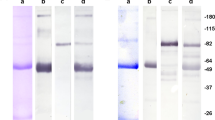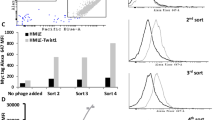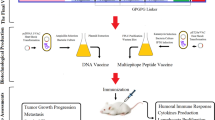Abstract
Existence of humoral immunity has been previously demonstrated in malignant ascitic fluids. However, only a limited number of immunogenic tumor-associated antigens (TAAs) were identified, and few of which are associated with ovarian cancer. Here, we identified salt-inducible kinase 3 (SIK3) as a TAA through screening of a random peptide library in the phage display system. Overexpression of SIK3 markedly promoted cell proliferation, attenuated p21Waf/Cip1 and p27Kip expressions in low-grade OVCAR3 cells, and permitted the cells to grow in mice. Decrease in SIK3 expression in high-grade SK-OV3 cells consistently demonstrated its tumorigenic potency by modulating the protein levels of cell cycle regulators. When the expressions of SIK3 and CA125 were compared in cancer tissues, immunohistochemical (IHC) studies indicated that cytoplasm-localized SIK3 was highly expressed in 55% of the ovarian cancer samples. In contrast, it was rarely detected in adenomyosis, leiomyoma and normal ovary tissues, showing its higher specificity (97%) to CA125 (65%) in ovarian cancer. Moreover, experiments using pharmacological inhibitors to block SIK3-induced p21Waf/Cip1 expression revealed that activation of c-Src and phosphoinositide-3-kinase were critically required for its biological activity, suggesting that they are the downstream signaling mediators of SIK3. These data were further supported by IHC studies, showing coexpression of c-Src with SIK3 in 85% of the ovarian tumor samples stained positive for SIK3. Collectively, our findings indicate that SIK3 is a novel ovarian TAA. Overexpression of SIK3 promotes G1/S cell cycle progression, bestows survival advantages to cancer cells for growth and correlates the clinicopathological conditions of patients with ovarian cancer.
This is a preview of subscription content, access via your institution
Access options
Subscribe to this journal
Receive 50 print issues and online access
$259.00 per year
only $5.18 per issue
Buy this article
- Purchase on Springer Link
- Instant access to full article PDF
Prices may be subject to local taxes which are calculated during checkout










Similar content being viewed by others
Accession codes
References
Ahmed AA, Lu Z, Jennings NB, Etemadmoghadam D, Capalbo L, Jacamo RO et al. (2010). SIK2 is a centrosome kinase required for bipolar mitotic spindle formation that provides a potential target for therapy in ovarian cancer. Cancer Cell 18: 109–121.
Amin N, Khan A, St Johnston D, Tomlinson I, Martin S, Brenman J et al. (2009). LKB1 regulates polarity remodeling and adherens junction formation in the Drosophila eye. Proc Natl Acad Sci USA 106: 8941–8946.
Baron AT, Boardman CH, Lafky JM, Rademaker A, Liu D, Fishman DA et al. (2005). Soluble epidermal growth factor receptor (sEGFR) [corrected] and cancer antigen 125 (CA125) as screening and diagnostic tests for epithelial ovarian cancer. Cancer Epidemiol Biomarkers Prev 14: 306–318.
Berdeaux R, Goebel N, Banaszynski L, Takemori H, Wandless T, Shelton GD et al. (2007). SIK1 is a class II HDAC kinase that promotes survival of skeletal myocytes. Nat Med 13: 597–603.
Brewer BG, Mitchell RA, Harandi A, Eaton JW . (2009). Embryonic vaccines against cancer: an early history. Exp Mol Pathol 86: 192–197.
Bright NJ, Thornton C, Carling D . (2009). The regulation and function of mammalian AMPK-related kinases. Acta Physiol (Oxf) 196: 15–26.
Cannistra SA . (2004). Cancer of the ovary. N Engl J Med 351: 2519–2529.
Cantley LC . (2002). The phosphoinositide 3-kinase pathway. Science 296: 1655–1657.
Chang GC, Liu KJ, Hsieh CL, Hu TS, Charoenfuprasert S, Liu HK et al. (2006). Identification of alpha-enolase as an autoantigen in lung cancer: its overexpression is associated with clinical outcomes. Clin Cancer Res 12: 5746–5754.
Cheng H, Liu P, Wang ZC, Zou L, Santiago S, Garbitt V et al. (2009). SIK1 couples LKB1 to p53-dependent anoikis and suppresses metastasis. Sci Signal 2: ra35.
Deng C, Zhang P, Harper JW, Elledge SJ, Leder P . (1995). Mice lacking p21CIP1/WAF1 undergo normal development, but are defective in G1 checkpoint control. Cell 82: 675–684.
Gagnon A, Kim JH, Schorge JO, Ye B, Liu B, Hasselblatt K et al. (2008). Use of a combination of approaches to identify and validate relevant tumor-associated antigens and their corresponding autoantibodies in ovarian cancer patients. Clin Cancer Res 14: 764–771.
Giancotti FR, Dorsett BH, Qian HN, Cronin WJ, Barber HR, Ioachim HL . (1990). Ovarian cancer-associated antibodies recovered from ascites: their use for the isolation of ovarian cancer-associated antigen to produce monoclonal antibodies. Gynecol Oncol 37: 24–28.
Guarino M . (2007). Epithelial-mesenchymal transition and tumour invasion. Int J Biochem Cell Biol 39: 2153–2160.
Horike N, Takemori H, Katoh Y, Doi J, Min L, Asano T et al. (2003). Adipose-specific expression, phosphorylation of Ser794 in insulin receptor substrate-1, and activation in diabetic animals of salt-inducible kinase-2. J Biol Chem 278: 18440–18447.
Katoh Y, Takemori H, Horike N, Doi J, Muraoka M, Min L et al. (2004). Salt-inducible kinase (SIK) isoforms: their involvement in steroidogenesis and adipogenesis. Mol Cell Endocrinol 217: 109–112.
Katoh Y, Takemori H, Lin XZ, Tamura M, Muraoka M, Satoh T et al. (2006). Silencing the constitutive active transcription factor CREB by the LKB1-SIK signaling cascade. FEBS J 273: 2730–2748.
Kowanetz M, Lonn P, Vanlandewijck M, Kowanetz K, Heldin CH, Moustakas A . (2008). TGFbeta induces SIK to negatively regulate type I receptor kinase signaling. J Cell Biol 182: 655–662.
Liu G, Yang G, Chang B, Mercado-Uribe I, Huang M, Zheng J et al. (2010). Stanniocalcin 1 and ovarian tumorigenesis. J Natl Cancer Inst 102: 812–827.
Lizcano JM, Goransson O, Toth R, Deak M, Morrice NA, Boudeau J et al. (2004). LKB1 is a master kinase that activates 13 kinases of the AMPK subfamily, including MARK/PAR-1. Embo J 23: 833–843.
Mizrachy-Schwartz S, Kravchenko-Balasha N, Ben-Bassat H, Klein S, Levitzki A . (2007). Optimization of energy-consuming pathways towards rapid growth in HPV-transformed cells. PLoS One 2: e628.
O'Brien TJ, Beard JB, Underwood LJ, Shigemasa K . (2002). The CA 125 gene: a newly discovered extension of the glycosylated N-terminal domain doubles the size of this extracellular superstructure. Tumour Biol 23: 154–169.
Okamoto M, Takemori H, Katoh Y . (2004). Salt-inducible kinase in steroidogenesis and adipogenesis. Trends Endocrinol Metab 15: 21–26.
Old LJ . (2008). Cancer vaccines: an overview. Cancer Immun 8 (Suppl 1): 1.
Paciga M, McCudden CR, Londos C, DiMattia GE, Wagner GF . (2003). Targeting of big stanniocalcin and its receptor to lipid storage droplets of ovarian steroidogenic cells. J Biol Chem 278: 49549–49554.
Reuschenbach M, von Knebel Doeberitz M, Wentzensen N . (2009). A systematic review of humoral immune responses against tumor antigens. Cancer Immunol Immunother 58: 1535–1544.
Rosenthal AN, Menon U, Jacobs IJ . (2006). Screening for ovarian cancer. Clin Obstet Gynecol 49: 433–447.
Ruda JM, Beus KS, Hollenbeak CS, Wilson RP, Stack Jr BC . (2006). The effect of single agent oral fusaric acid (FA) on the growth of subcutaneously xenografted SCC-1 cells in a nude mouse model. Invest New Drugs 24: 377–381.
Runnebaum IB, Stickeler E . (2001). Epidemiological and molecular aspects of ovarian cancer risk. J Cancer Res Clin Oncol 127: 73–79.
Screaton RA, Conkright MD, Katoh Y, Best JL, Canettieri G, Jeffries S et al. (2004). The CREB coactivator TORC2 functions as a calcium- and cAMP-sensitive coincidence detector. Cell 119: 61–74.
Serlachius M, Alitalo R, Olsen HS, Andersson LC . (2002). Expression of stanniocalcin-1 in megakaryocytes and platelets. Br J Haematol 119: 359–363.
Sjostrom M, Stenstrom K, Eneling K, Zwiller J, Katz AI, Takemori H et al. (2007). SIK1 is part of a cell sodium-sensing network that regulates active sodium transport through a calcium-dependent process. Proc Natl Acad Sci USA 104: 16922–16927.
Taylor DD, Gercel-Taylor C, Parker LP . (2009). Patient-derived tumor-reactive antibodies as diagnostic markers for ovarian cancer. Gynecol Oncol 115: 112–120.
Acknowledgements
This work was partially supported by the Intramural Research Grant of the National Health Research Institutes, the National Research Program for Genomic Medicine Grant from the Department of Health, Executive Yuan, Taiwan, DOH97-TD-G-111-022 (NYS), and by the National Science Council Grants of Taiwan, NSC 99-2320-B-400-011-MY3 (NYS), NSC 96-2314-B-038-022 (SJL), NSC 97-2314-B-038-004-MY3 (SJL), as well as NSC 96-2320-B-038-005/NSC 97-2320-B-038-012-MY2 (YYY). We are also grateful to Dr Nagase from the Kazusa DNA Research Institute for kindly providing the FJ10213 plasmid to facilitate the SIK3 study, and thank National Research Program for Genomic Medicine, Taiwan (National Clinical Core, NSC-95-3112-B-001-010 and National Genotyping Core, NSC-95-3112-B-001-011) for supply of interfering small hairpin RNA plasmids.
Author information
Authors and Affiliations
Corresponding authors
Ethics declarations
Competing interests
The authors declare no conflict of interest.
Additional information
Supplementary Information accompanies the paper on the Oncogene website
Rights and permissions
About this article
Cite this article
Charoenfuprasert, S., Yang, YY., Lee, YC. et al. Identification of salt-inducible kinase 3 as a novel tumor antigen associated with tumorigenesis of ovarian cancer. Oncogene 30, 3570–3584 (2011). https://doi.org/10.1038/onc.2011.77
Received:
Revised:
Accepted:
Published:
Issue Date:
DOI: https://doi.org/10.1038/onc.2011.77
Keywords
This article is cited by
-
Tumor metabolism rewiring in epithelial ovarian cancer
Journal of Ovarian Research (2023)
-
Salt-inducible kinase inhibition sensitizes human acute myeloid leukemia cells to all-trans retinoic acid-induced differentiation
International Journal of Hematology (2021)
-
The potent roles of salt-inducible kinases (SIKs) in metabolic homeostasis and tumorigenesis
Signal Transduction and Targeted Therapy (2020)
-
Identification of female-specific genetic variants for metabolic syndrome and its component traits to improve the prediction of metabolic syndrome in females
BMC Medical Genetics (2019)
-
Infiltrating bone marrow mesenchymal stem cells increase prostate cancer stem cell population and metastatic ability via secreting cytokines to suppress androgen receptor signaling
Oncogene (2014)



